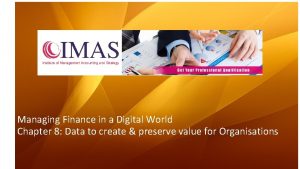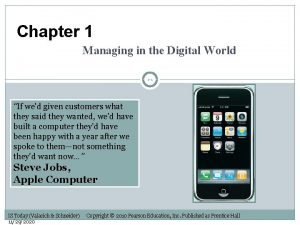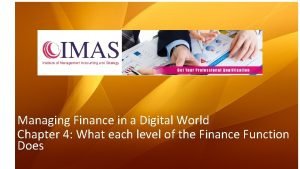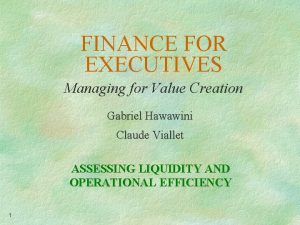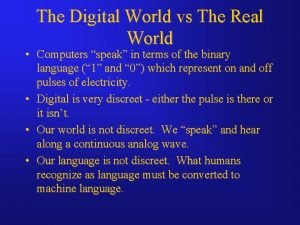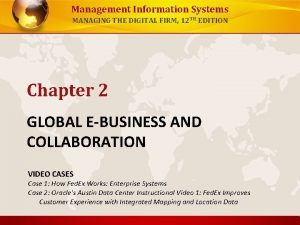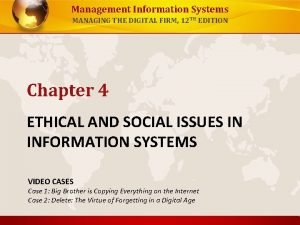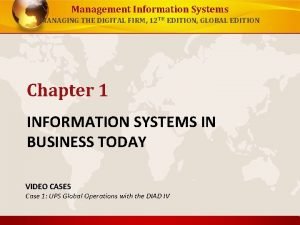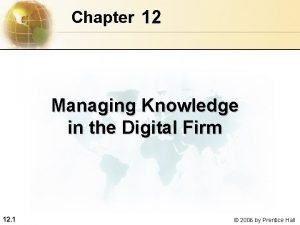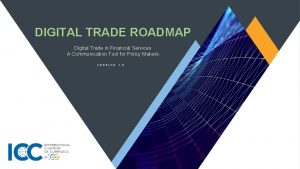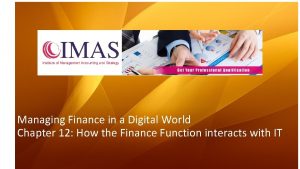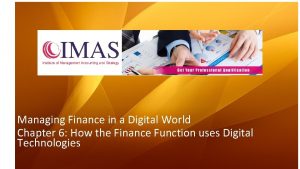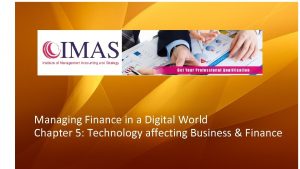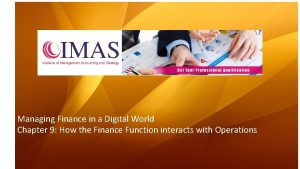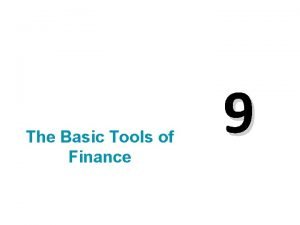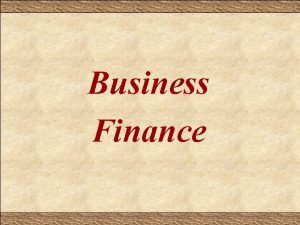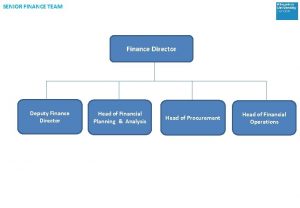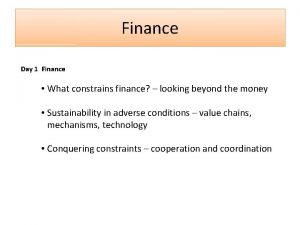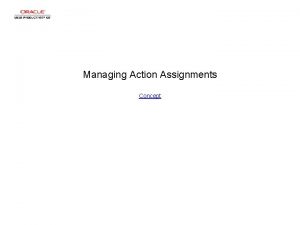Managing Finance in a Digital World Chapter 4

























- Slides: 25

Managing Finance in a Digital World Chapter 4: What each level of the Finance Function Does

What each level of the Finance Function does Learning Outcome D 2. Explain what each level of the Finance Function does Component D 2) Explain the activities of: a) Finance operations b) Specialist areas including Financial Reporting & Financial Planning & Analysis(FP&A) c) Strategic Partnering for value d) Strategic leadership of the Finance team § Finance operations to generate information & preliminary insight. § FP&A, taxation, corporate reporting, decision support to produce insight. § Business partnering to influence organisation to make appropriate decisions. § Leading the Finance team to create the required impact for the organisation. 2

The Four Levels of the Diamond Shape

Finance Operations(level 4) • Finance operations generate information and preliminary insight. • This becomes the foundation of the work of finance professionals and there are four, often inter-related components. 4

Financial Reporting Financial Accounting § Financial (or corporate) reporting is concerned with the production of financial information for external users in accordance with relevant accounting standards and legislation. § The financial information may include: ü Financial statements ü Tax reporting ü Regulatory reporting. § The following external users will use the information in their decision making and for assessing the stewardship of the business’s management. • • • Shareholders Customers Suppliers Bond holders Banks Tax authorities 5

Key Elements of Financial Accounting There are three main financial statements produced by most businesses each year. These are: • Statement of profit or loss (SOPL) • Income as well as the costs incurred in an accounting period. • Statement of financial position (SOFP) • Assets and liabilities of the business. Stake the owners have in organisation (or their ‘capital’). • Statement of cash flows • summarises the cash receipts and payments for the year. Shows whether the company is solvent (has sufficient cash) and where the cash was moved/spent. There a number of ratios that are important to investors & these include: Earnings Per Share = Profit After Tax / Weighted Average Number of Shares Price to Earnings Ratio = Share Price / Earnings Per Share Dividend Yield = Dividend per share / Current Share Price x 100 6

Management Accounting • Process of measuring, analysing, interpreting and communicating information internally to management in a form which is easy for them to understand. • Its the provision of information to help managers and other internal users in their decision making, performance measurement, planning and control activities. 7

Management Accounting 3 most common management reports. Budgeting: quantified financial plan for a forthcoming accounting period. Budget is useful: • Co-ordination – Goal congruence and teamwork • Responsibility – allows management to take responsbilities for decisions • Utilisation – Maximise efficiency of resources • Motivation –Influencing behaviour and motivating performance • Planning – Force constant evaluation of future opportunities & threats • Evaluation – Basis of management appraisal • Telling – Communication of expectations Cost Control & Cost Schedules • Monitor the budget and ensure that the divisions remain within their budget targets • Used for: Investment appraisal, break even analysis, pricing decisions Variance analysis – actual vs budget • Used for: prevent recoccurence of adverse variance, identify & repeat favourable variance 8

Treasury Management § is the management of the funds of the business, namely cash and other working capital items, plus longterm investments, short and long-term debt, and equity finance § Generation of external and internal funds, management of currencies, cashflows and policies and procedures on corporate finance 9

Working Capital Management Working Capital – Capital available for conducting day to day operations: excess of current assets over current liabilities. Conservative approach: Policy of holding large working capital balance Aggressive approach: Hold low working capital balance 10

Financing Finance required to grow and invest. There are two main types of external finance: Debt Borrowing from 3 rd party with obligation to repay, usually with interest. Advantages: § Interest payments are allowable against tax. Note that dividend payments made to shareholders are not an allowable deduction. § Does not change the ownership of the organisation. § Cheaper to service than equity, as it is often secured against the assets of the company and takes priority over equity in liquidation – less risk Equity Selling a stake/shares in the business to new or existing shareholders. Advantages: § No minimum level of dividend that must be paid to shareholders. Dividends can be suspended if profits are low. Interest payments on debt must be paid each year. § Does not require assets as security. Some companies may lack quality assets to offer, making equity more attractive as it does not require security. 11

Currency Management & Tax Currency Risk - potential change in the exchange rate of one currency to another. Methods of managing exchange rate risks: § Matching- receipts in foreign currency matched against payments in the same currency § Lagging-pay later to match against funds received in that currency or in anticipation of favourable exchange rate movement § Leading-pay early using funds that already received in that currency or in anticipation of unfavourable exchange rate movements § Invoicing in home currency- passing risk on to customers § External hedging-forwards, options, futures, money market hedging Effective Tax management • Tax avoidance – legal use of rules to one’s advantage to reduce tax liability • Tax mitigation – legal use of rules to ones advantage without frustrating the intentions of governement policy. • Tax evasion – illegally deliberately misrepresenting financial status to reduce tax liablity 12

Internal Audit - Independent activity, established by management to examine and evaluate the organisation’s risk management processes and systems of control, to make recommendations for the achievement of company objectives. 13

Internal Audit & Corporate Governance • A properly functioning internal audit department is part of good corporate governance • Internal audit enables management to perform proper risk assessments • The Corporate Governance Code requires annual review of: • The need for internal audit function (if one does not exist) • Scope of its work, authority and resources. • Should be staffed with qualified, experienced staff, monitored by an audit committee. Scope of Internal Audit: • reviewing internal controls and financial reports • reviewing risk management systems • carrying out special assignments (e. g. fraud investigations) • conducting operational reviews (e. g. into efficiency of parts of the business). 14

Internal Audit & Fraud 3 Elements must be present for Fraud to occur: 1. Dishonesty 2. Opportunity 3. Motivation • Factors indicating an increased risk of fraud: 1. Management domination by one person 2. Unnecessarily complex corporate structures 3. Poor staff morale 4. Personel not taking time off 5. Lavish employee lifestyle 6. Inadequate segregation of duties 7. Lack of monitoring of control systems 8. Unusual transactions 9. Payments for services disproprotionate to effort • • Implications of fraud: Loss of shareholder confidence Loss of assets Financial difficulties Collapse of company Fines by tax and other authorities 15

Internal Audit & Fraud Controls are key element of fraud prevention, typical controls include: § Staff supervision § Approval and authorisation § Segregation of duties § Accounting controls such as reconciliation § Strong recruitment procedures to ensure trustworthy and loyal staff § A culture that stress the importance of integrity and honesty Limitations of internal audit • unavoidable independence problem • will only succeed if it is properly staffed and resourced • If internal auditors identify fraud, they may be unwilling to disclose it for fear of the repercussions These limitations can be reduced if an audit committee: • sets the work agenda for internal audit • receives internal audit reports • is able to ensure the internal audit is properly resourced • has a ‘voice’ at main board level. 16

Specialist Areas(level 3) The specialists are experts who provide insight derived from the information that has been handed to them (at level 4). The finance function works alongside these specialists providing support for decisions and projects 17

Specialist Areas(level 3) Recent Changes to Specialist Areas 1. Finance function evolution to a diamond shape ü Has expanded business partnering between finance function and specialist areas. ü Increased number of specialist areas tasks being offered by SSCs. 2. Technology ü Used by specialists and by the finance function when working with specialists The use of advanced technology and the creation of SSCs have resulted in ‘digital centres of excellence’ at this level (level 3) of the diamond shape. 18

Strategic Partnering for Value(level 2) Communicating insight to influence users At the next level of the diamond shape of the finance function, the insights that level 3 provide will be passed on to finance professionals working as strategic partners (level 2). These strategic partners will: ü Interpret and use financial statements and other data to communicate this insight ü in an appropriate format ü and required frequency ü to internal and external stakeholders. to influence users of this information in their decision making an implementation of control activities. The evolving shape of the finance function means that more people will be needed at this level and the finance function will need to develop the competencies required to adequately carry out this activity. 19

Strategic Partnering for Value(level 2) Business partnering § The finance function will act as a business partner influencing the organisation’s decisions to achieve the desired impact. § Successful finance business partners are seen as leaders that can influence the decisions that a business makes to maximise value. § Business partnering services may be provided by: – individual finance function employees working alongside departmental managers – a multi-disciplinary team in a centre of excellence – a mix of both. 20

Strategic Leadership of the Finance team(level 1) The head of the finance function is the chief financial officer (CFO) and it is their responsibility to lead the finance team to achieve the desired organisational impact: ü Lead key initiatives that support the organisational goals. ü Execute and fund strategies set by the CEO. ü Liaise effectively with internal and external stakeholders The CFO will need to put a team in place that has the appropriate knowledge, skills and experience to effectively execute all of the activities in the Finance Function. CFOs are increasingly taking a more active leadership role working alongside and with the CEO as a ‘co-pilot’ in the success of the business. Today’s CFO need a wider skill set: ü Possessing strong analytical & communication skills ü & mastering areas outside of finance such as regulation, risk management, business transformation, supply chain management & IT 21

The Impact of Technologies Organisations are using technology to support the automation of management information processes and to provide reporting to the rest of the business on a self-serve basis: • This is resulting in a narrowing of the level 4 activities (diamond shape) of finance operations to generate information and preliminary insight. • It has also increased the need for skills and talent at level 2 (working with specialists to provide further insight) and level 3 (communicating insight to influence users and business partnering to influence and impact the organisation). 22

The Impact of Technologies New data sources and analysis methods New data sources and advanced methods for analysing this data (for example, predictive analysis has improved forecasting) are providing opportunities for better informed decision making. Automation and cognitive computing A 2016 Mc. Kinsey report studied which functions could be automated by advancing technology: 23

The Impact of Technologies The illustration can be overlaid across the diamond shape of the finance function: New technology being used include: ü Robotic process automation (RPA) is providing opportunities to automate many routine, clerical activities. ü Cognitive computing (such as artificial intelligence (AI), machine learning and natural language programming) provides opportunities to automate, say, advanced data analytics and report writing. 24

Test Your Knowledge ?
 Managing finance in a digital world
Managing finance in a digital world Managing in a digital world
Managing in a digital world Managing in a digital world
Managing in a digital world Finance in a digital world
Finance in a digital world Finance for executives: managing for value creation
Finance for executives: managing for value creation Real world vs digital world
Real world vs digital world Managing digital marketing
Managing digital marketing Managing digital communications
Managing digital communications Management information system managing the digital firm
Management information system managing the digital firm Management information systems managing the digital firm
Management information systems managing the digital firm Managing the digital firm
Managing the digital firm Managing knowledge in the digital firm
Managing knowledge in the digital firm Sffcu auto loan rates
Sffcu auto loan rates Digital finance roadmap
Digital finance roadmap Ap world history chapter 25 africa and the atlantic world
Ap world history chapter 25 africa and the atlantic world Apa yang dimaksud dengan warga digital.
Apa yang dimaksud dengan warga digital. Digital markets and digital goods
Digital markets and digital goods Digital data digital signals
Digital data digital signals Data encoding and modulation
Data encoding and modulation E-commerce: digital markets, digital goods
E-commerce: digital markets, digital goods Data encoding techniques
Data encoding techniques Healthtech mobility
Healthtech mobility Unique features of digital markets
Unique features of digital markets Chapter 1 managing risk when driving
Chapter 1 managing risk when driving Chapter 8 managing stress and anxiety
Chapter 8 managing stress and anxiety Leasiest
Leasiest
